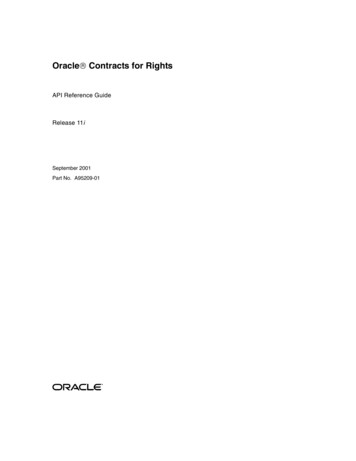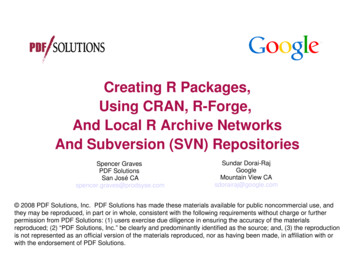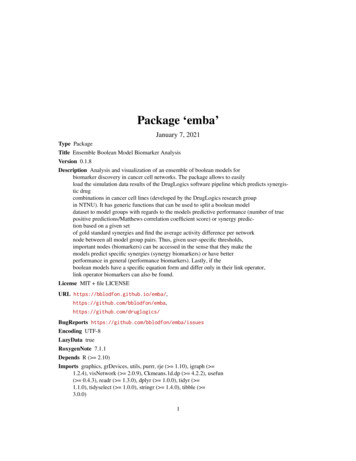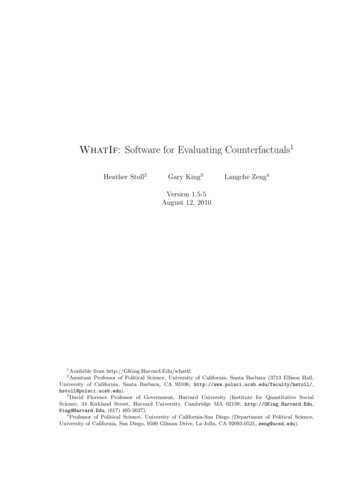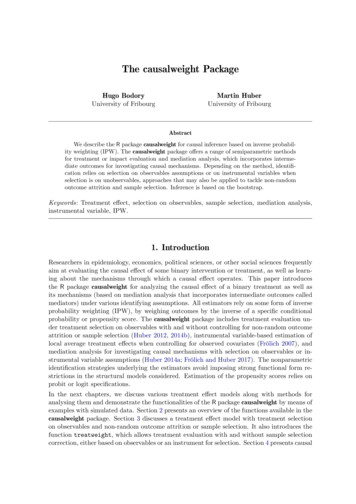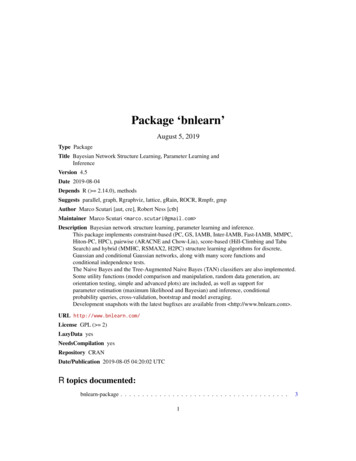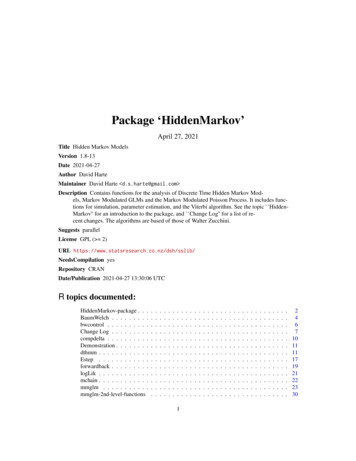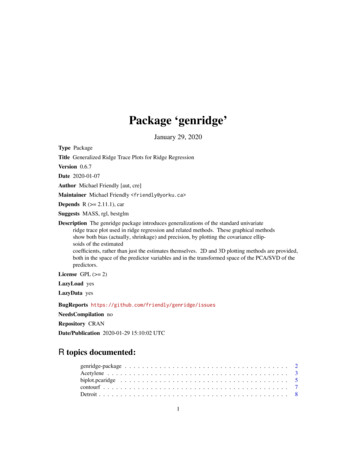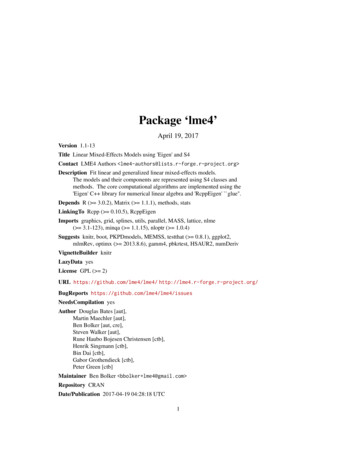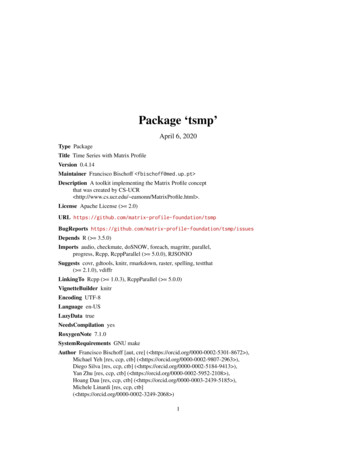
Transcription
Package ‘tsmp’April 6, 2020Type PackageTitle Time Series with Matrix ProfileVersion 0.4.14Maintainer Francisco Bischoff fbischoff@med.up.pt Description A toolkit implementing the Matrix Profile conceptthat was created by CS-UCR http://www.cs.ucr.edu/ eamonn/MatrixProfile.html .License Apache License ( 2.0)URL ugReports issuesDepends R ( 3.5.0)Imports audio, checkmate, doSNOW, foreach, magrittr, parallel,progress, Rcpp, RcppParallel ( 5.0.0), RJSONIOSuggests covr, gdtools, knitr, rmarkdown, raster, spelling, testthat( 2.1.0), vdiffrLinkingTo Rcpp ( 1.0.3), RcppParallel ( 5.0.0)VignetteBuilder knitrEncoding UTF-8Language en-USLazyData trueNeedsCompilation yesRoxygenNote 7.1.0SystemRequirements GNU makeAuthor Francisco Bischoff [aut, cre] ( https://orcid.org/0000-0002-5301-8672 ),Michael Yeh [res, ccp, ctb] ( https://orcid.org/0000-0002-9807-2963 ),Diego Silva [res, ccp, ctb] ( https://orcid.org/0000-0002-5184-9413 ),Yan Zhu [res, ccp, ctb] ( https://orcid.org/0000-0002-5952-2108 ),Hoang Dau [res, ccp, ctb] ( https://orcid.org/0000-0003-2439-5185 ),Michele Linardi [res, ccp, ctb]( https://orcid.org/0000-0002-3249-2068 )1
R topics documented:2Repository CRANDate/Publication 2020-04-06 17:10:02 UTCR topics documented:analyze . . . . . . . .as.matrixprofile . . . .av apply . . . . . . . .av complexity . . . . .av hardlimit artifact .av motion artifact . .av stop word . . . . .av zerocrossing . . . .compute . . . . . . . .discords . . . . . . . .dist profile . . . . . .fast avg sd . . . . . .fast movavg . . . . . .fast movsd . . . . . .find chains . . . . . .find discord . . . . . .find motif . . . . . . .find snippet . . . . . .floss . . . . . . . . . .floss cac . . . . . . . .floss extract . . . . . .fluss . . . . . . . . . .fluss cac . . . . . . . .fluss extract . . . . . .fluss score . . . . . . .get data . . . . . . . .mass v3 . . . . . . . .min mp idx . . . . . .motifs . . . . . . . . .motifs discords smallmpdist . . . . . . . . .mpx . . . . . . . . . .mp fluss data . . . . .mp gait data . . . . .mp meat data . . . . .mp test data . . . . .mp toy data . . . . .mstomp par . . . . . .plot . . . . . . . . . .plot arcs . . . . . . . .pmp . . . . . . . . . .pmp upper bound . 23334343536373839404042464749
analyze3read . . . . . . . . .remove class . . . .salient mds . . . . .salient score . . . .salient subsequencesscrimp . . . . . . . .sdts predict . . . . .sdts score . . . . . .sdts train . . . . . .set data . . . . . . .simple fast . . . . .stamp par . . . . . .stompi update . . . .stomp par . . . . . .tsmp . . . . . . . . .valmod . . . . . . .visualize . . . . . . .write . . . . . . . . zeRuns an appropriate workflow based on the parameters passed in.DescriptionThe goal of this function is to compute all fundamental algorithms on the provided time series data.See details for more information.Usageanalyze(ts,windows NULL,query NULL,sample pct 1,threshold 0.98,n jobs 1L)Argumentstsa matrix or a vector. The time series to analyze.windowsan int or a vector. The window(s) to compute the Matrix Profile. Note that itmay be an int for a single matrix profile computation or a vector of int forcomputing the Pan-Matrix Profile.querya matrix or a vector. Optional The query to analyze. Note that when computing the Pan-Matrix Profile the query is ignored!
4analyzesample pcta numeric. A number between 0 and 1 representing how many samples to compute for the Matrix Profile or Pan-Matrix Profile. When it is 1, the exact algorithm is used. (default is 1.0).thresholda numeric. Correlation threshold. See details. (Default is 0.98).n jobsan int. The number of cpu cores to use when computing the MatrixProfile.(default is 1).DetailsFor now the following is computed:1. Matrix Profile - exact or approximate based on sample pct given that a single windows isprovided. By default is the exact algorithm;2. Top 3 Motifs;3. Top 3 Discords;4. Plot Matrix Profile, Motifs and Discords.When windows is not provided or more than a single window is provided, the Pan-Matrix Profile iscomputed:1. Compute the upper bound when a threshold is provided (it is, by default);2. Compute Pan-Matrix Profile for all windows provided, below the upper bound, or a defaultrange when no windows is provided;3. Top Motifs;4. Top Discords;5. Plot Pan-Matrix Profile, motifs and discords.ValueThe appropriate Matrix Profile or Pan-Matrix Profile profile object and also plots the graphics.ReferencesWebsite: http://www.cs.ucr.edu/ eamonn/MatrixProfile.htmlSee AlsoOther Main API: compute(), discords(), motifs(), visualize()Examples# Matrix Profileresult - analyze(mp toy data data[, 1], 80)# Pan Matrix Profileresult - analyze(mp toy data data[, 1])
as.matrixprofile5as.matrixprofileConvert a TSMP object into another if possibleDescriptionThe base Classes are MatrixProfile and MultiMatrixProfile, but as other functions are used,classes are pushed behind, since the last output normally is the most significant. If you want, forexample, to plot the Matrix Profile from a Fluss object, you may use as.matrixprofile() to castit .mp)as.arccount(.mp)as.salient(.mp)Arguments.mpa TSMP object.ValueReturns the object with the new class, if possible.Functions as.matrixprofile: Cast an object changed by another function back to MatrixProfile. as.multimatrixprofile: Cast an object changed by another function back to MultiMatrixProfile. as.pmp: Cast an object changed by another function back to PMP.
6av apply as.valmod: Cast an object changed by another function back to MultiMatrixProfile. as.fluss: Cast an object changed by another function back to Fluss. as.chain: Cast an object changed by another function back to Chain. as.discord: Cast an object changed by another function back to Discord. as.motif: Cast an object changed by another function back to Motif. as.multimotif: Cast an object changed by another function back to MultiMotif. as.arccount: Cast an object changed by another function back to ArcCount. as.salient: Cast an object changed by another function back to Salient.Examplesw - 50data - mp gait datamp - tsmp(data, window size w, exclusion zone 1 / 4, verbose 0)mp - find motif(mp)class(mp) # first class will be "Motif"plot(mp) # plots a motif plotplot(as.matrixprofile(mp)) # plots a matrix profile plotav applyCorrects the matrix profile using an annotation vectorDescriptionThis function overwrites the current Matrix Profile using the Annotation Vector. Use with caution.Usageav apply(.mp)Arguments.mpA Matrix Profile with an Annotation Vector.ValueReturns the input .mp object corrected by the embedded annotation vector.References Dau HA, Keogh E. Matrix Profile V: A Generic Technique to Incorporate Domain Knowledgeinto Motif Discovery. In: Proceedings of the 23rd ACM SIGKDD International Conferenceon Knowledge Discovery and Data Mining - KDD ’17. New York, New York, USA: ACMPress; 2017. p. 125-34.
av complexity7See AlsoOther Annotation vectors: av complexity(), av hardlimit artifact(), av motion artifact(),av stop word(), av zerocrossing()Examplesdata - mp test data train data[1:1000]w - 50mp - tsmp(data, window size w, verbose 0)mp - av complexity(mp)av - av apply(mp)av complexityComputes the annotation vector that favors complexityDescriptionComputes the annotation vector that favors complexityUsageav complexity(.mp, data, dilution factor 0, apply FALSE)Arguments.mpa Matrix Profile object.dataa vector or a column matrix of numeric.dilution factora numeric. (Default is 0). Larger numbers means more dilution.applylogical. (Default is FALSE). Applies the Annotation Vector over the Matrix Profile. Use with caution.ValueReturns the input .mp object with an embedded annotation vector.References Dau HA, Keogh E. Matrix Profile V: A Generic Technique to Incorporate Domain Knowledgeinto Motif Discovery. In: Proceedings of the 23rd ACM SIGKDD International Conferenceon Knowledge Discovery and Data Mining - KDD ’17. New York, New York, USA: ACMPress; 2017. p. 125-34.See AlsoOther Annotation vectors: av apply(), av hardlimit artifact(), av motion artifact(),av stop word(), av zerocrossing()
8av hardlimit artifactExamplesdata - mp test data train data[1:1000]w - 50mp - tsmp(data, window size w, verbose 0)av - av complexity(mp, apply TRUE)av hardlimit artifact Computes the annotation vector that suppresses hard-limited artifactsDescriptionComputes the annotation vector that suppresses hard-limited artifactsUsageav hardlimit artifact(.mp, data, apply FALSE)Arguments.mpa Matrix Profile object.dataa vector or a column matrix of numeric.applylogical. (Default is FALSE). Applies the Annotation Vector over the Matrix Profile. Use with caution.ValueReturns the input .mp object with an embedded annotation vector.References Dau HA, Keogh E. Matrix Profile V: A Generic Technique to Incorporate Domain Knowledgeinto Motif Discovery. In: Proceedings of the 23rd ACM SIGKDD International Conferenceon Knowledge Discovery and Data Mining - KDD ’17. New York, New York, USA: ACMPress; 2017. p. 125-34.See AlsoOther Annotation vectors: av apply(), av complexity(), av motion artifact(), av stop word(),av zerocrossing()Examplesdata - mp test data train data[1:1000]w - 50mp - tsmp(data, window size w, verbose 0)av - av hardlimit artifact(mp, apply TRUE)
av motion artifact9av motion artifactComputes the annotation vector that suppresses motion artifactsDescriptionComputes the annotation vector that suppresses motion artifactsUsageav motion artifact(.mp, data, apply FALSE)Arguments.mpa Matrix Profile object.dataa vector or a column matrix of numeric.applylogical. (Default is FALSE). Applies the Annotation Vector over the Matrix Profile. Use with caution.ValueReturns the input .mp object with an embedded annotation vector.References Dau HA, Keogh E. Matrix Profile V: A Generic Technique to Incorporate Domain Knowledgeinto Motif Discovery. In: Proceedings of the 23rd ACM SIGKDD International Conferenceon Knowledge Discovery and Data Mining - KDD ’17. New York, New York, USA: ACMPress; 2017. p. 125-34.See AlsoOther Annotation vectors: av apply(), av complexity(), av hardlimit artifact(), av stop word(),av zerocrossing()Examplesdata - mp test data train data[1:1000]w - 50mp - tsmp(data, window size w, verbose 0)av - av motion artifact(mp, apply TRUE)
10av stop wordav stop wordComputes the annotation vector that suppresses stop-word motifsDescriptionComputes the annotation vector that suppresses stop-word motifsUsageav stop word(.mp,data,stop word loc,exclusion zone NULL,threshold 0.1,apply FALSE)Arguments.mpa Matrix Profile object.dataa vector or a column matrix of numeric.stop word locan int. The index of stop word location.exclusion zone a numeric. Size of the exclusion zone, based on window size (default is NULL).See details.thresholda numeric. (default is 0.1).applylogical. (Default is FALSE). Applies the Annotation Vector over the Matrix Profile. Use with caution.DetailsThe function is intended to be generic. However, its parameters (stop word loc, exclusion zoneand threshold) are highly dataset dependent.ValueReturns the input .mp object with an embedded annotation vector.References Dau HA, Keogh E. Matrix Profile V: A Generic Technique to Incorporate Domain Knowledgeinto Motif Discovery. In: Proceedings of the 23rd ACM SIGKDD International Conferenceon Knowledge Discovery and Data Mining - KDD ’17. New York, New York, USA: ACMPress; 2017. p. 125-34.
av zerocrossing11See AlsoOther Annotation vectors: av apply(), av complexity(), av hardlimit artifact(), av motion artifact(),av zerocrossing()Examplesdata - mp test data train data[1:1000]w - 50mp - tsmp(data, window size w, verbose 0)av - av stop word(mp, stop word loc 150, apply TRUE)av zerocrossingComputes the annotation vector that favors number of zero crossingDescriptionComputes the annotation vector that favors number of zero crossingUsageav zerocrossing(.mp, data, apply FALSE)Arguments.mpa Matrix Profile object.dataa vector or a column matrix of numeric.applylogical. (Default is FALSE). Applies the Annotation Vector over the Matrix Profile. Use with caution.ValueReturns the input .mp object with an embedded annotation vector.References Dau HA, Keogh E. Matrix Profile V: A Generic Technique to Incorporate Domain Knowledgeinto Motif Discovery. In: Proceedings of the 23rd ACM SIGKDD International Conferenceon Knowledge Discovery and Data Mining - KDD ’17. New York, New York, USA: ACMPress; 2017. p. 125-34.See AlsoOther Annotation vectors: av apply(), av complexity(), av hardlimit artifact(), av motion artifact(),av stop word()
12computeExamplesdata - mp test data train data[1:1000]w - 50mp - tsmp(data, window size w, verbose 0)av - av zerocrossing(mp, apply TRUE)computeComputes the Matrix Profile or Pan-Matrix ProfileDescriptionMain API FunctionUsagecompute(ts,windows NULL,query NULL,sample pct 1,threshold 0.98,n jobs 1L)Argumentstsa matrix or a vector. The time series to analyze.windowsan int or a vector. The window(s) to compute the Matrix Profile. Note that itmay be an int for a single matrix profile computation or a vector of int forcomputing the Pan-Matrix Profile.querya matrix or a vector. Optional The query to analyze. Note that when computing the Pan-Matrix Profile the query is ignored!sample pcta numeric. A number between 0 and 1 representing how many samples to compute for the Matrix Profile or Pan-Matrix Profile. When it is 1, the exact algorithm is used. (default is 1.0).thresholda numeric. Correlation threshold. See details. (Default is 0.98).n jobsan int. The number of cpu cores to use when computing the MatrixProfile.(default is 1).DetailsComputes the exact or approximate Matrix Profile based on the sample percent specified. Currently,MPX and SCRIMP are used for the exact and approximate algorithms respectively. See detailsfor more information about the arguments combinations.When a single windows is given, the Matrix Profile is computed. If a query is provided, AB joinis computed. Otherwise the self-join is computed. When multiple windows or none are given, the
discords13Pan-Matrix Profile is computed. If a threshold is set (it is, by default), the upper bound will becomputed and the given windows or a default range (when no windows), below the upper boundwill be computed.ValueThe profile computed.ReferencesWebsite: http://www.cs.ucr.edu/ eamonn/MatrixProfile.htmlSee AlsoOther Main API: analyze(), discords(), motifs(), visualize()Examples# Matrix Profileresult - compute(mp toy data data[, 1], 80)# Pan-Matrix Profileresult - compute(mp toy data data[, 1])discordsSearch for DiscordDescriptionSearch for DiscordUsagediscords(profile,exclusion zone profile ez,k 3L,neighbor count 10L,radius 3)
14dist profileArgumentsprofilea MatrixProfile or PMP object.exclusion zone an int. Number of values to exclude on both sides of the motif to avoid trivial matches. Defaults to the exclusion zone used to compute the (Pan-)MatrixProfile which is found in the profile data structure.kan int. Number of discords to find. (Default is 3).neighbor count an int. Number of neighbors to find. (Default is 3).radiusan int. Set a threshold to exclude matching neighbors with distance currentdiscord distance * radius. (Default is 3).ReferencesWebsite: http://www.cs.ucr.edu/ eamonn/MatrixProfile.htmlSee AlsoOther Main API: analyze(), compute(), motifs(), visualize()dist profileCalculates the distance profile using MASS algorithmsDescriptionMueen’s Algorithm for Similarity Search is The Fastest Similarity Search Algorithm for Time Series Subsequences under Euclidean Distance and Correlation Coefficient.Usagedist profile(data,query,.,window size NULL,method "v3",index 1,k NULL,weight NULL,paa 1)
dist profile15Argumentsdataa matrix or a vector.querya matrix or a vector. See details.Precomputed values from the first iteration. If not supplied, these values will becomputed.window sizean int or NULL. Sliding window size. See details.methodmethod that will be used to calculate the distance profile. See details.indexan int. Index of query window. See details.kan int or NULL. Default is NULL. Defines the size of batch for MASS V3. Preferto use a power of 2. If NULL, it will be set automatically.weighta vector of numeric or NULL with the same length of the window size. This isa MASS extension to weight the query.paaa numeric. Default is 1. Factor of PAA reduction (2 half of size). This is aMASS extension.DetailsThis function has several ways to work:Case 1: You have a small sized query and the data. In this case you only have to provide the firsttwo parameters data and query. Internally the window size will be get from the query length.Case 2: You have one or two data vectors and want to compute the join or self-similarity. In thiscase you need to use the recursive solution. The parameters are data, query, window size andindex. The first iteration don’t need the index unless you are starting somewhere else. The querywill be the source of a query window, starting on index, with length of window size.The method defines which MASS will be used. Current supported values are: v2, v3, weighted.ValueReturns the distance profile for the given query and the last product for STOMP algorithmand the parameters for recursive call. See details.References Abdullah Mueen, Yan Zhu, Michael Yeh, Kaveh Kamgar, Krishnamurthy Viswanathan, ChetanKumar Gupta and Eamonn Keogh (2015), The Fastest Similarity Search Algorithm for TimeSeries Subsequences under Euclidean DistanceWebsite: https://www.cs.unm.edu/ mueen/FastestSimilaritySearch.htmlExamplesw - mp toy data sub lenref data - mp toy data data[, 1]# minimum example, data and querynn - dist profile(ref data, ref data[1:w])
16fast avg sddistance profile - sqrt(nn distance profile)# data and indexed querynn - dist profile(ref data, ref data, window size w, index 10)distance profile - sqrt(nn distance profile)# recursivenn - NULLfor (i in seq len(10)) {nn - dist profile(ref data, ref data, nn, window size w, index i)}# weightedweight - c(rep(1, w / 3), rep(0.5, w / 3), rep(0.8, w / 3)) # just an examplenn - dist profile(ref data, ref data,window size w, index 1, method "weighted",weight weight)distance profile - sqrt(nn distance profile)fast avg sdFast implementation of moving average and moving standard deviationDescriptionThis function does not handle NA valuesUsagefast avg sd(data, window size, rcpp FALSE)Argumentsdataa vector or a column matrix of numeric.window sizemoving sd window sizercppa logical. Uses rcpp implementation.ValueReturns a list with avg and sd vectors
fast movavgfast movavg17Fast implementation of moving averageDescriptionThis function does not handle NA valuesUsagefast movavg(data, window size)Argumentsdatawindow sizea vector or a column matrix of numeric.moving sd window sizeValueReturns a vector with the moving averageExamplesdata avg - fast movavg(mp toy data data[, 1], mp toy data sub len)fast movsdFast implementation of moving standard deviationDescriptionThis function does not handle NA valuesUsagefast movsd(data, window size, rcpp FALSE)Argumentsdatawindow sizercppa vector or a column matrix of numeric.moving sd window sizea logical. Uses rcpp implementation.ValueReturns a vector with the moving standard deviationExamplesdata sd - fast movsd(mp toy data data[, 1], mp toy data sub len)
18find discordfind chainsFind Time Series ChainsDescriptionTime Series Chains is a new primitive for time series data mining.Usagefind chains(.mp)Arguments.mpa MatrixProfile object.ValueReturns the input .mp object with a new name chain. It contains: chains, a list of chains foundwith more than 2 patterns and best with the best one.References Zhu Y, Imamura M, Nikovski D, Keogh E. Matrix Profile VII: Time Series Chains: A NewPrimitive for Time Series Data Mining. Knowl Inf Syst. 2018 Jun 2;1-27.Website: plesw - 50data - mp gait datamp - tsmp(data, window size w, exclusion zone 1 / 4, verbose 0)mp - find chains(mp)find discordDescriptionSearch for DiscordSearch for Discord
find discord19Usagefind discord(.mp, .)## S3 method for class 'MatrixProfile'find discord(.mp,data,n discords 1,n neighbors 3,radius 3,exclusion zone NULL,.)## S3 method for class 'PMP'find discord(.mp,data,n discords 1,n neighbors 3,radius 3,exclusion zone NULL,.)Arguments.mpa MatrixProfile object.further arguments to be passed to class specific function.datathe data used to build the Matrix Profile, if not embedded.n discordsan int. Number of discords to find. (Default is 1).n neighborsan int. Number of neighbors to find. (Default is 3).radiusan int. Set a threshold to exclude matching neighbors with distance currentdiscord distance * radius. (Default is 3).exclusion zone if a number will be used instead of embedded value. (Default is NULL).ValueFor class MatrixProfile, returns the input .mp object with a new name discord. It contains:discord idx, a vector of discords foundFor class PMP, returns the input .mp object with a new name discord. It contains: discord idx, avector of discords foundExamples# Single dimension dataw - 50
20find motifdata - mp gait datamp - tsmp(data, window size w, exclusion zone 1 / 4, verbose 0)mp - find discord(mp)pan - tsmp(mp gait data, window size 20:30, mode "pmp")mp - find discord(pan)find motifSearch for MotifsDescriptionSearch for MotifsUsagefind motif(.mp, .)## S3 method for class 'MatrixProfile'find motif(.mp,data,n motifs 3,n neighbors 10,radius 3,exclusion zone NULL,.)## S3 method for class 'MultiMatrixProfile'find motif(.mp,data,n motifs 3,mode c("guided", "unconstrained"),n bit 4,exclusion zone NULL,n dim NULL,.)## S3 method for class 'PMP'find motif(.mp,data,n motifs 3,n neighbors 10,radius 3,
find motif)21exclusion zone NULL,.Arguments.mpa MatrixProfile or MultiMatrixProfile object.further arguments to be passed to class specific function.datathe data used to build the Matrix Profile, if not embedded.n motifsan int. Number of motifs to find. (Default is 3).n neighborsan int. Number of neighbors to find. (Default is 10).radiusan int. Set a threshold to exclude matching neighbors with distance currentmotif distance * radius. (Default is 3).exclusion zone if a number will be used instead of embedded value. (Default is NULL).modea string. Guided or Unconstrained search. Allow partial match. (Default isguided).n bitan int. Bit size for discretization. Ignored on Guided search. (Default is 4).n diman int. Number of dimensions to use on Guided search instead of embeddedvalue. (Default is NULL).ValueFor class MatrixProfile, returns the input .mp object with a new name motif. It contains:motif idx, a list of motif pairs found and motif neighbor a list with respective motif’s neighbors.For class MultiMatrixProfile, returns the input .mp object with a new name motif. It contains:motif idx, a vector of motifs found and motif dim a list the dimensions where the motifs werefoundFor class PMP, returns the input .mp object with a new name motif. It contains: motif idx, a listof motif pairs found and motif neighbor a list with respective motif’s neighbors.Examples# Single dimension dataw - 50data - mp gait datamp - tsmp(data, window size w, exclusion zone 1 / 4, verbose 0)mp - find motif(mp)# Multidimension dataw - mp toy data sub lendata - mp toy data data[1:200, ]mp - tsmp(data, window size w, mode "mstomp", verbose 0)mp - find motif(mp)pan - tsmp(mp gait data, window size 20:30, mode "pmp")mp - find motif(pan)
22find snippetfind snippetTime Series Snippets: A New Primitive for Time Series Data MiningDescriptionTime Series Snippets tries to solve mainly the common problem of summarization "Show me somerepresentative/typical data". As stated by the original paper, potential uses of snippets are: integrating summarizations of files directly into an operating, production of automatically generatedreports, for example, summarize a sleep study and also can be used to support a host of higher-leveltasks, including the comparison of massive data collections.Usagefind snippet(data, s size, n snippets 2L, window size s size/2L)Argumentsdataa matrix or a vector.s sizean int. Size of snippet.n snippetsan int. Number of snippets to find. (Default is 2).window sizean int. The size of the sliding window used to compare the data. Must besmaller than s size. (Default is s size / 2).DetailsMotifs vs. snippets: While motifs reward fidelity of conservation, snippets also rewards coverage.Informally, coverage is some measure of how much of the data is explained or represented by agiven snippet.Shapelets vs. snippets: shapelets are defined as subsequences that are maximally representative ofa class. Shapelets are supervised, snippets are unsupervised. Shapelets are generally biased to beas short as possible. In contrast, we want snippets to be longer, to intuitively capture the "flavor" ofthe time series.ValueReturns the snippet : a list of n snippets snippets fraction : fraction of each snippet snippetidx : thelocation of each snippet within time seriesReferences Imani S, Madrid F, Ding W, Crouter S, Keogh E. Matrix Profile XIII: Time Series Snippets:A New Primitive for Time Series Data Mining. In: 2018 IEEE International Conference onData Mining (ICDM). 2018. Gharghabi S, Imani S, Bagnall A, Darvishzadeh A, Keogh E. Matrix Profile XII: MPdist: ANovel Time Series Distance Measure to Allow Data Mining in More Challenging Scenarios.In: 2018 IEEE International Conference on Data Mining (ICDM). 2018.
floss23Website: essnippets - find snippet(mp fluss data walkjogrun data[1:300], 40, n snippets 2)snippets - find snippet(mp fluss data walkjogrun data, 120, n snippets 3)plot(snippets)flossFast Low-cost Online Semantic Segmentation (FLOSS)DescriptionFast Low-cost Online Semantic Segmentation (FLOSS)Usagefloss(.mp,new data,data window,threshold 1,exclusion zone NULL,chunk size NULL,keep cac TRUE)Arguments.mpa MatrixProfile object.new dataa matrixor vector of new observations.data windowan int. Sets the size of the buffer used to keep track of semantic changes.thresholda number. (Default is 1). Set the maximum value for evaluating semanticchanges. This is data specific. It is advised to check what is ’normal’ for yourdata.exclusion zone if a number will be used instead of embedded value. (Default is NULL).chunk sizean int . (Default is NULL). Set the size of new data that will be added to Flossin each iteration if new data is large. If NULL, the size will be 50. This is notneeded if new data is small, like 1 observation.keep caca logical. (Default is TRUE). If set to FALSE, the cac final will contain onlyvalues within data window
24floss cacValueReturns the input .mp object new names: cac the corrected arc count, cac finalthe combination ofcac after repeated calls of floss(), floss with the location of semantic changes and floss valswith the normalized arc count value of the semantic change positions.References Gharghabi S, Ding Y, Yeh C-CM, Kamgar K, Ulanova L, Keogh E. Matrix Profile VIII: Domain Agnostic Online Semantic Segmentation at Superhuman Performance Levels. In: 2017IEEE International Conference on Data Mining (ICDM). IEE
Jul 6, 2022
